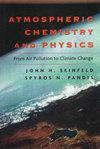The annual cycle and sources of relevant aerosol precursor vapors in the central Arctic
IF 5.2
1区 地球科学
Q1 ENVIRONMENTAL SCIENCES
引用次数: 0
Abstract
Abstract. In this study, we present and analyze the first continuous timeseries of relevant aerosol precursor vapors from the central Arctic during the Multidisciplinary drifting Observatory for the Study of Arctic Climate (MOSAiC) expedition. These precursor vapors include sulfuric acid (SA), methanesulfonic acid (MSA), and iodic acid (IA). We use FLEXPART simulations, inverse modeling, sulfur dioxide (SO2) mixing ratios, and chlorophyll-a (chl-a) observations to interpret the 20 seasonal variability of the vapor concentrations and identify dominant sources. Our results show that both natural and anthropogenic sources are relevant for the concentrations of SA in the Arctic, but anthropogenic sources associated with Arctic haze are the most prevalent. MSA concentrations are an order of magnitude higher during polar day than during polar night due to seasonal changes in biological activity. Peak MSA concentrations were observed in May, which corresponds with the timing of the annual peak in chl-a concentrations north of 75° N. IA concentrations exhibit two distinct peaks during 25 the year: a dominant peak in spring and a secondary peak in autumn, suggesting that seasonal IA concentrations depend on both solar radiation and sea ice conditions. In general, the seasonal cycles of SA, MSA, and IA in the central Arctic Ocean are related to sea ice conditions, and we expect that changes in the Arctic environment will affect the concentrations of these vapors in the future. The magnitude of these changes and the subsequent influence on aerosol processes remains uncertain, highlighting the need for continued observations of these precursor vapors in the Arctic.北极中部相关气溶胶前体蒸汽的年周期和来源
摘要在这项研究中,我们首次对北极气候研究多学科漂流观测站(MOSAiC)考察期间北极中部相关气溶胶前体蒸汽的连续时间序列进行了介绍和分析。这些前体蒸汽包括硫酸(SA)、甲磺酸(MSA)和碘酸(IA)。我们利用 FLEXPART 模拟、反演建模、二氧化硫(SO2)混合比和叶绿素-a(chl-a)观测数据来解释水汽浓度的 20 个季节性变化,并确定主要来源。我们的研究结果表明,自然和人为来源都与北极地区的 SA 浓度有关,但与北极雾霾有关的人为来源最为普遍。由于生物活动的季节性变化,极昼的 MSA 浓度比极夜高出一个数量级。在 5 月份观测到的 MSA 浓度峰值与北纬 75 度以北 chl-a 浓度的年度峰值时间一致。IA 浓度在一年中表现出两个明显的峰值:春季为主要峰值,秋季为次要峰值,表明季节性 IA 浓度取决于太阳辐射和海冰条件。总的来说,北冰洋中部的 SA、MSA 和 IA 的季节性周期与海冰条件有关,我们预计北极环境的变化将在未来影响这些蒸气的浓度。这些变化的程度以及随后对气溶胶过程的影响仍不确定,因此需要对北极的这些前体蒸汽进行持续观测。
本文章由计算机程序翻译,如有差异,请以英文原文为准。
求助全文
约1分钟内获得全文
求助全文
来源期刊

Atmospheric Chemistry and Physics
地学-气象与大气科学
CiteScore
10.70
自引率
20.60%
发文量
702
审稿时长
6 months
期刊介绍:
Atmospheric Chemistry and Physics (ACP) is a not-for-profit international scientific journal dedicated to the publication and public discussion of high-quality studies investigating the Earth''s atmosphere and the underlying chemical and physical processes. It covers the altitude range from the land and ocean surface up to the turbopause, including the troposphere, stratosphere, and mesosphere.
The main subject areas comprise atmospheric modelling, field measurements, remote sensing, and laboratory studies of gases, aerosols, clouds and precipitation, isotopes, radiation, dynamics, biosphere interactions, and hydrosphere interactions. The journal scope is focused on studies with general implications for atmospheric science rather than investigations that are primarily of local or technical interest.
 求助内容:
求助内容: 应助结果提醒方式:
应助结果提醒方式:


